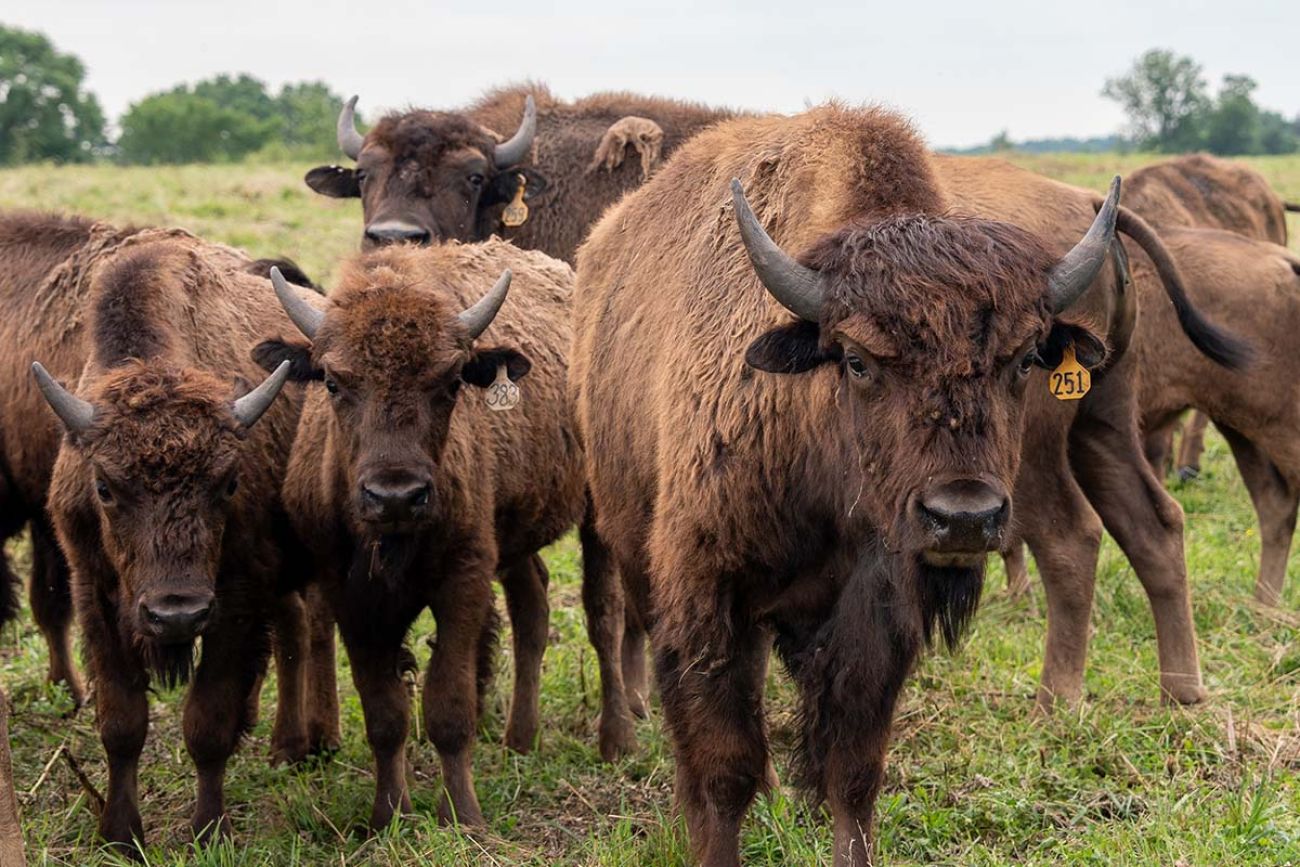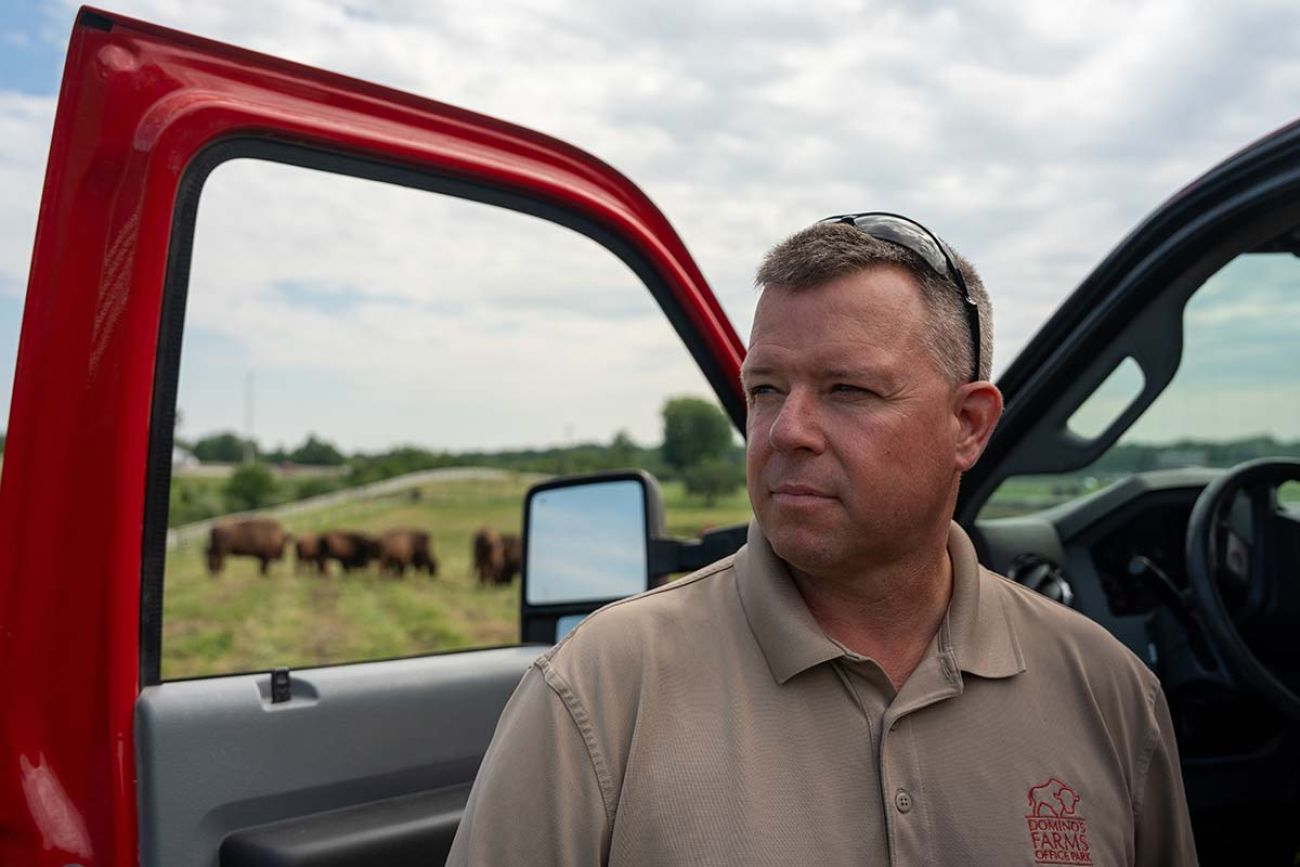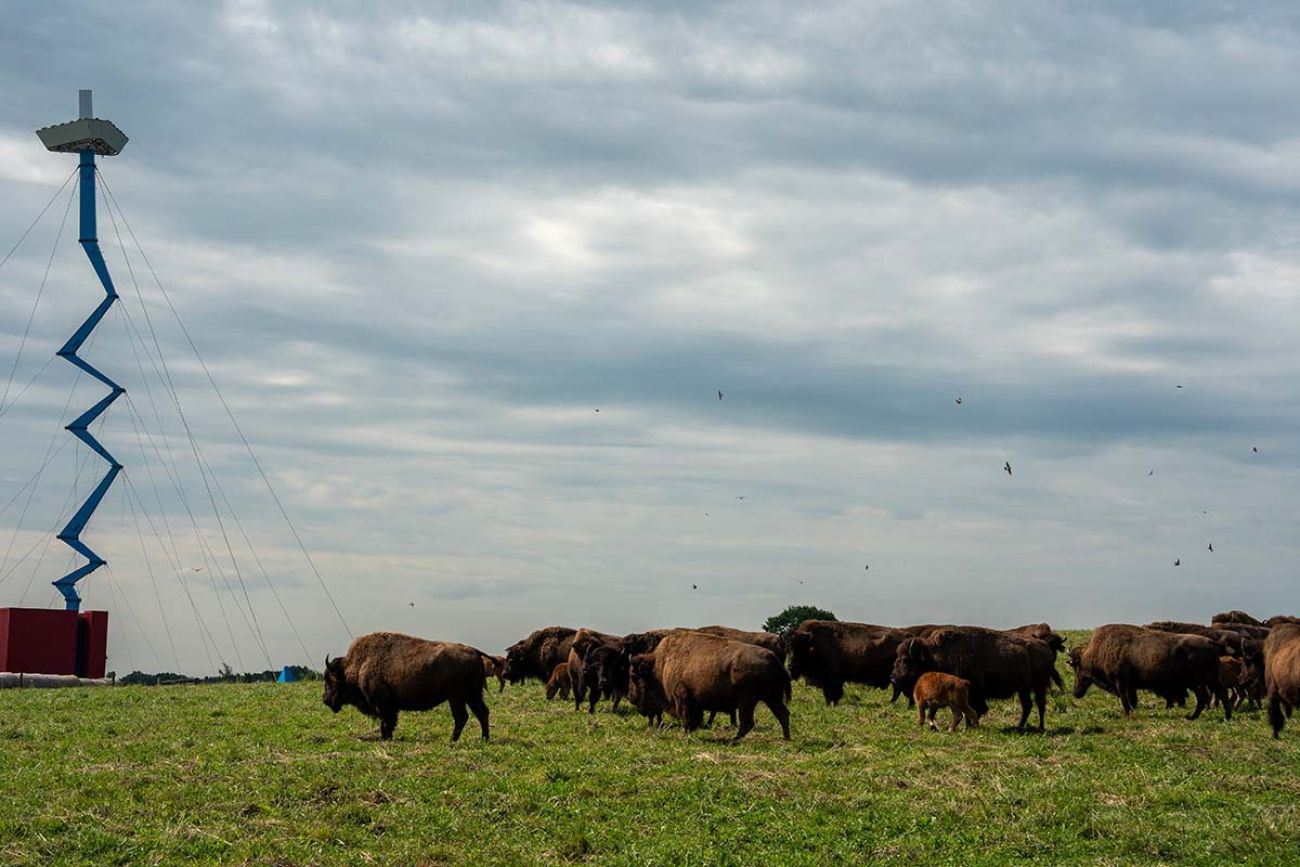Michigan’s ‘bison wrangler’ shares secrets of the Domino’s Farms herd

- Bison were saved from extinction in the mid-1800s, and private ranches preserve them today
- Domino’s Farms ranch manager Todd Crocker has dedicated his life to maintaining the show herd
- About 2,000 U.S. ranches herd 400,000 bison
ANN ARBOR — On the northeast edge of Ann Arbor, between M-14 and Domino’s Farms, is where the buffalo roam.
There, drivers on their daily commute can often catch a glimpse of a herd of 75 bison, grazing across a 90-acre pasture that is part of the Domino’s Farms complex. If they look closely enough, they may also see the beat-up red Ford pickup of Todd Crocker, the herd’s official bison wrangler.
Thirty-two years ago, Crocker was a new 18-year-old employee at Domino’s, who was put in charge of the business park’s first two bison because the more seasoned workers wanted no part of the big, angry-looking creatures. He knew little to nothing about the animals.
Now, Crocker is a nationally known buffalo manager, whose pampered bison are part of Michigan’s most-awarded show herd.
“I’ve always been an animal nut,” he said. “I care about the safety and wellbeing of every animal on this farm.”
Related:
- Michigan approves new deer hunting regulations to address overpopulation
- Sault Tribe restocks U.P. waterways with walleye, whitefish
- In rural Michigan, farmers split over big solar
Crocker sees bison as the once-lost icon of North America. The Smithsonian’s National Zoo and Conservation Biology Institute estimates a population of over 30 million once lived across the country, including southern Michigan. They were saved from near-extinction in the late 1800s, and private ranches have served to restore the species.
Domino’s Farms introduced bison to the complex in 1993 to complete the vision of its owner and Domino’s Pizza founder, Tom Monaghan. The business park’s spokesperson, John Petz, said its architecture draws inspiration from Frank Lloyd Wright with pastures and art pieces surrounding the main complex.
The farm’s 75 bison belong to a show herd, bred and raised to win awards in regional competitions. Bison that are aggressive, unable to reproduce or otherwise can no longer compete are harvested for meat.

‘Unique in the bison world’
Crocker, now 50, has been working with animals since his Ann Arbor childhood. He claims to be among the country’s most experienced bison experts. He has pioneered the industry’s safest roundup techniques and worked with Michigan State University students to develop a new feed containing a blend of nutrients and minerals for the herd.
“It’s crazy to think I’ve been managing bison for 32 years and they’ve only been managed for 150,” he said. “Having my knowledge base makes me kind of unique in the bison world, a lot of people call me for a lot of different reasons.”
Over 400,000 bison can be found across the country but they are “functionally extinct,” meaning they aren’t a part of any ecosystem today. Crocker said all American buffalo are managed — including the nation’s biggest herd of 6,000 in Yellowstone National Park.
Crocker said bison are a resilient species, but they couldn’t be reintroduced into the wild today. The large, open plains bison need to graze and roam are now filled with crop fields and roads.
“Bison will travel hundreds of miles,” he said. “The way the Midwest is developed, I don’t think you could give them the range they need.”
And no driver wants to look up and see a buffalo crossing the road. “You see what happens when a car hits a 150-pound deer,” Crocker said. “Now imagine that with a 1,500-pound animal.”
Just one bad day
Crocker has learned to read the animals and their behavior, going as far to recognize which bison are “friends” with one another.
Crocker typically works sunrise to sunset, seven days a week managing the herd. He directs a team of handlers who maintain the pastures, and he coordinates with various suppliers to get them what they need. In case of an emergency, he’s always on-call.
Crocker says his priority is keeping the bison happy until they’re taken to slaughter. The bison get plenty of specially formulated food, artisan mineral water (no tap water for them) and even sprinklers on hot days.
“I really do pamper them,” he said. “I assure you that the bison in this field only have one bad day in their life.”
According to the National Bison Association, 80,000 buffalo were harvested in 2023. For comparison, over 125,000 cattle are harvested each day in the US.
And Crocker loves the taste of bison as much as he loves the animals themselves.
“It’s way better for you than cattle, it’s phenomenal,” he said. “You have to try a bison burger at least once in your life.”
Crocker said people need to understand one important thing about bison: don’t treat them like cows.
“Cattle have been domesticated over the course of 5,000 years,” he said. “The aggressive genotype eventually got out of the herd and they became broken in spirit, from what I see.”
If people get too close to the bison, they will attack or run. The herd’s largest can weigh over 2,000 pounds, stand about 6 feet tall and can run at speeds up to 40 miles per hour.

“People think you can go up and take a picture with bison. You can’t do that. Part of them is still wild, even here,” he said.
Two sets of fences — one electrified — separate the bison pasture from the business complex.
And Crocker said the fences are for people, not the bison.
“We’ve had bison get out twice in 30 years, it’s rare. They have the ability to run through all those fences, but they stay here because they like it here,” he said.
The best way for Domino’s Farms visitors to see the bison is from a distance, he said, in a clearing behind the main complex near a model of the incomplete “Leaning Tower of Pizza.”
While bison can be dangerous, people can also be a danger to animals. Stressful encounters elevate the heart rates of bison, and they can lose hundreds of pounds over prolonged periods of travel to shows.

Crocker and his team of six are trained in low-stress handling for the bison, especially during their annual roundup in early spring. The roundup allows the team to count, tag and inspect the herd up close.
“What many ranches won’t tell you is that they lose one to two bison in each roundup from stress,” he said. “Their bodies just can’t handle it. But we don’t lose any.”
Crocker is sure he was born to manage bison.
Having a strong connection with the herd makes the long hours at the farm worth it, Crocker said. He recalled his favorite bull, Rowdy, who would regularly approach him to be pet.
“Rowdy would come over to me in the field and put his head through the (truck) window,” he said. “He never wanted for anything and literally died of old age on the farm.”
With his rare time off, Crocker said he likes to relax with a game of golf or a day at the beach. One day, he hopes to see the bison of Yellowstone and other herds out west.
“I don’t even want to think about how many hours I work a week. I work Christmas Eve, Christmas,” he said, “Every holiday, I’m here. I love it. It’s a lifestyle more than a job.”
Michigan Environment Watch
Michigan Environment Watch examines how public policy, industry, and other factors interact with the state’s trove of natural resources.
- See full coverage
- Subscribe
- Share tips and questions with Bridge environment reporter Kelly House
Michigan Environment Watch is made possible by generous financial support from:
Our generous Environment Watch underwriters encourage Bridge Michigan readers to also support civic journalism by becoming Bridge members. Please consider joining today.
See what new members are saying about why they donated to Bridge Michigan:
- “In order for this information to be accurate and unbiased it must be underwritten by its readers, not by special interests.” - Larry S.
- “Not many other media sources report on the topics Bridge does.” - Susan B.
- “Your journalism is outstanding and rare these days.” - Mark S.
If you want to ensure the future of nonpartisan, nonprofit Michigan journalism, please become a member today. You, too, will be asked why you donated and maybe we'll feature your quote next time!






